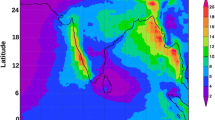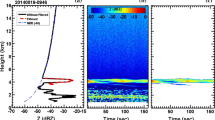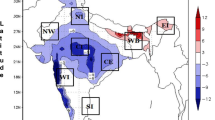Abstract
Tropics nurture three different types of convective clouds, i.e., shallow cumulus, cumulus congestus, and deep cumulonimbus. The vertical structure of clouds holds a crucial metric in studying tropical clouds. Ground-based high-resolution cloud radar measurements are the potential candidate in exploring the characteristics of various types of tropical clouds and their evolution. Quality-controlled cloud radar data containing a total of five million vertical profiles of equivalent reflectivity factor (VPR) are used to examine the intra-seasonal variation of cloud vertical structure (VSC) during the Indian summer monsoon (ISM) over Mandhardev (18.04° N, 73.87° E, and ~ 1.3 km AMSL) in the Indian Western Ghats. The cumulus congestus (Cc) in the transition of shallow to deep clouds is investigated for the first time using the hourly VPR data for 60 consecutive ISM days. Mid-level moistening plays a vital role in this non-precipitating shallow to precipitating congestus transformation and increment of the rain accumulation. Low cloud reflectivity distribution can distinguish precipitating and non-precipitating clouds that help to classify the observed monsoon as normal or below normal. More than 150 mm of rain accumulation during ISM is associated with more than 22% of high clouds. This particular aspect indicates that cold rain processes are essential to assess the ISM over the observational site. FFT analysis on the time series of low-, mid-, and high-level cloud regions with the VPR shows prominent intra-seasonal variability of 5–10, 10–20, and 30–60 days periodicities. This study highlights the significance of VSC over tropics pertinent to the monsoon large scale atmospheric condition.

Source Figure: Johnson et al. (1999). Further, the macro (micro)-physical sub-division levels/estates are namely low (warm), mid (mixed) and high (ice)-cloud regions. Two overlays dashed lines correspond to the altitude at 0° and – 40 °C over the Western Ghats



















Similar content being viewed by others
References
Benedict JJ, Randall DA (2007) Observed characteristics of the MJO relative to maximum rainfall. J Atmos Sci 64(7):2332–2354
Brenguier JL, Wood R (2009) Observational strategies from the micro to mesoscale. In: Heintzenberg J, Charlson RJ (eds) Clouds in the perturbed climate system: their relationship to energy balance, atmospheric dynamics, and precipitation. MIT Press, Cambridge, pp 487–510
Choudhury AD, Krishnan R, Ramarao MVS, Vellore R, Singh M, Mapes B (2018) A phenomenological paradigm for midtropospheric cyclogenesis in the Indian summer monsoon. J Atmos Sci 75(9):2931–2954
Cui Z, Carslaw KS, Blyth AM (2011) The coupled effect of mid-tropospheric moisture and aerosol abundance on deep convective cloud dynamics and microphysics. Atmosphere 2(3):222–241
Del Genio AD, Chen Y, Kim D, Yao MS (2012) The MJO transition from shallow to deep convection in CloudSat/CALIPSO data and GISS GCM simulations. J Clim 25(11):3755–3770
Devasthale A, Fueglistaler S (2010) A climatological perspective of deep convection penetrating the TTL during the Indian summer monsoon from the AVHRR and MODIS instruments. Atmos Chem Phys. https://doi.org/10.5194/Acp-10-4573-2010
Devasthale A, Grassl H (2009) A daytime climatological distribution of high opaque ice cloud classes over the Indian summer monsoon region observed from 25-year AVHRR data. Atmos Chem Phys 9:4185–4196
Dutta U, Chaudhari HS, Hazra A, Pokhrel S, Saha SK, Veeranjaneyulu C (2020) Role of convective and microphysical processes on the simulation of monsoon intraseasonal oscillation. Clim Dyn 55:2377–2403
Francis PA, Gadgil S (2006) Intense rainfall events over the west coast of India. Meteorol Atmos Phys 94(1–4):27–42
Gadgil S (2003) The Indian monsoon and its variability. Annu Rev Earth Planet Sci 31(1):429–467
Gao W, Sui CH, Hu Z (2014) A study of macrophysical and microphysical properties of warm clouds over the Northern Hemisphere using CloudSat/CALIPSO data. J Geophys Res Atmos 119(6):3268–3280
Goswami BN (2005) South Asian monsoon. In Intraseasonal variability in the atmosphere-ocean climate system. Springer, Berlin, pp 19–61
Gunn R, Kinzer GD (1949) The terminal velocity of fall for water droplets in stagnant air. J Meteor 6(4):243–248
Johnson RH, Rickenbach TM, Rutledge SA, Ciesielski PE, Schubert WH (1999) Trimodal characteristics of tropical convection. J Clim 12:2397
Kakatkar R, Gnanaseelan C, Chowdary JS, Parekh A, Deepa JS (2018) Indian summer monsoon rainfall variability during 2014 and 2015 and associated Indo-Pacific upper ocean temperature patterns. Theoret Appl Climatol 131(3–4):1235–1247
Kalapureddy MCR, Sukanya P, Das SK, Deshpande SM, Pandithurai G, Pazamany AL, Annam S (2018) A simple biota removal algorithm for 35 GHz cloud radar measurements. Atmos Meas Tech. https://doi.org/10.5194/amt-11-1417-2018
KaSPR (2012) Calibration technical document prepared by ProSensing Inc., USA, (2012)
Kemball-Cook SR, Weare BC (2001) The onset of convection in the Madden–Julian oscillation. J Clim 14(5):780–793
Khouider B, Biello J, Majda AJ (2010) A stochastic multi-cloud model for tropical convection. Commun Math Sci 8(1):187–216
Kollias P, Clothiaux EE, Miller MA, Albrecht BA, Stephens GL, Ackerman TP (2007) Millimeter-wavelength radars: new frontier in atmospheric cloud and precipitation research. Bull Am Meteorol Soc 88:1608
Krishnamurti TN, Bhalme HN (1976) Oscillations of a monsoon system. Part I observational aspects. J Atmos Sci 33(10):1937–1954
Krishnamurti TN, Thomas A, Simon A, Kumar V (2010) Desert air incursions, an overlooked aspect, for the dry spells of the Indian summer monsoon. J Atmos Sci 67(10):3423–3441
Krishnan R, Zhang C, Sugi M (2000) Dynamics of breaks in the Indian summer monsoon. J Atmos Sci 57(9):1354–1372
Liu C, Zipser EJ, Cecil DJ, Nesbitt SW, Sherwood S (2008) A cloud and precipitation feature database from nine years of TRMM observations. J Appl Meteorol Climatol 47(10):2712–2728
Moncrieff MW, Waliser DE, Miller MJ, Shapiro MA, Asrar GR, Caughey J (2012) Multiscale convective organization and the YOTC virtual global field campaign. Bull Am Meteorol Soc 93(8):1171–1187
Nair AKM, Rajeev K, Mishra MK, Thampi BV, Parameswaran K (2012) Multiyear lidar observations of the descending nature of tropical cirrus clouds. J Geophys Res Atmos 117:D18
Rajeevan M, Rohini P, Kumar KN, Srinivasan J, Unnikrishnan CK (2013) A study of vertical cloud structure of the Indian summer monsoon using CloudSat data. Clim Dyn 40(3–4):637–650
Randall DA, Dazlich DA, Corsetti TG (1989) Interactions among radiation, convection, and large-scale dynamics in a general circulation model. J Atmos Sci 46(13):1943–1970
Rao YP (1976) Southwest monsoon, meteorological monograph. India Meteorological Department, New Delhi, p 366
Romatschke U, Houze RA Jr (2011) Characteristics of precipitating convective systems in the South Asian monsoon. J Meteorol. https://doi.org/10.1175/2010jhm1289.1American
Sassen K, Wang Z (2008) Classifying clouds around the globe with the CloudSat radar: 1-year of results. Geophys Res Lett. https://doi.org/10.1029/2007gl032591
Sikka DR, Gadgil S (1980) On the maximum cloud zone and the ITCZ over Indian, longitudes during the southwest monsoon. Mon Weather Rev 108(11):1840–1853
Slingo A, Slingo JM (1988) The response of a general circulation model to cloud longwave radiative forcing. I: Introduction and initial experiments. Q J R Meteorol Soc 114(482):1027–1062
Stephens GL (2005) Cloud Feedbacks in the climate system: a critical review. J Clim 18(2):237–273
Sukanya P, Kalapureddy MCR (2019) Cloud microphysical profile differences pertinent to monsoon phases: inferences from a cloud radar. Meteorol Atmos Phys 131(6):1723–1738. https://doi.org/10.1007/s00703-019-00666-9
Tiedtke M (1989) A comprehensive mass flux scheme for cumulus parameterization for large scale models. American Meteorological Society, Boston
Utsav B, Deshpande SM, Das SK, Pandithurai G (2017) Statistical characteristics of convective clouds over the Western Ghats derived from weather radar observations. J Geophys Res: Atmos 122(18):10050–10076
Utsav B, Deshpande SM, Das SK, Pandithurai G, Niyogi D (2019) Observed vertical structure of convection during dry and wet summer monsoon epochs over the Western Ghats. J Geophys Res Atmos 124(3):1352–1369
Wang J, Rossow WB, Zhang Y (2000) Cloud vertical structure and its variations from a 20-year global rawinsonde dataset. J Clim 13(17):3041–3056
Webster PJ, Magafia VO, Palmer TN, Shukla J, Tomas RA, Yanai M, Yasunari T (1998) Monsoons: processes, predictability, and the prospects for prediction. J Geophys Res 103(C7):14451–14510
Wielicki BA, Cess RD, King MD, Randall DA, Harrison EF (1995) Mission to planet Earth role of clouds and radiation in climate. Bull Am Meteorol Soc 76:2125
Acknowledgements
IITM is an autonomous organization that is fully funded by MOES, Govt. of India. Authors are grateful to Director, IITM, not only for his wholehearted support for strengthening the radar program but also for monitoring and acting as a source of inspiration to promote the radar research to the next heights. The authors are thankful to G. Pandithurai for encouraging discussions on the work and grateful to all those involved and helped in setting up and running the IITM's Cloud Radar Facility. The ERA-Interim data from the ECMWF (https://apps.ecmwf.int/datasets/). Authors also acknowledge Soumyajit Bose and Utsav Bhowmik for helping in analyzing massive radar and reanalysis data, respectively. The data supporting this article may be requested to the IITM radar data portal or corresponding author (kalapureddy1@gmail.com).
Author information
Authors and Affiliations
Corresponding author
Additional information
Publisher's Note
Springer Nature remains neutral with regard to jurisdictional claims in published maps and institutional affiliations.
Rights and permissions
About this article
Cite this article
Sukanya, P., Kalapureddy, M.C.R. Cloud radar observations of multi-scale variability of cloud vertical structure associated with Indian summer monsoon over a tropical location. Clim Dyn 56, 1055–1081 (2021). https://doi.org/10.1007/s00382-020-05520-y
Received:
Accepted:
Published:
Issue Date:
DOI: https://doi.org/10.1007/s00382-020-05520-y




